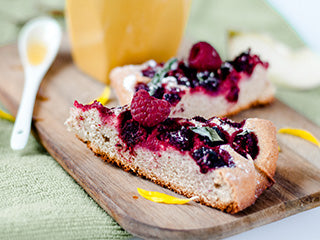
Raspberries Harvest 2015
We started growing raspberries in 90’s on our family farm near Cupar. Our cultivar has exeptional sweet taste with astringent flavor. These individually gathered berries are a wonderful taste of summer in your everyday meal. Raspberries are perfect in smoothies, baking, on pancakes or just plain old snacking out of the bag! Enjoy!
What's New and Beneficial About Raspberries (H2)
One of the most fascinating new areas of raspberry research involves the potential for raspberries to improve management of obesity. Although this research is in its early stages, scientists now know that metabolism in our fat cells can be increased by phytonutrients found in raspberries, especially rheosmin (also called raspberry ketone). By increasing enzyme activity, oxygen consumption, and heat production in certain types of fat cells, raspberry phytonutrients like rheosmin may be able to decrease risk of obesity as well as risk of fatty liver. In addition to these benefits, rheosmin can decrease activity of a fat-digesting enzyme released by our pancreas called pancreatic lipase. This decrease in enzyme activity may result in less digestion and absorption of fat.

Recent research on organic raspberries has now shown organic raspberries to be significantly higher in total antioxidant capacity than non-organic raspberries. Raspberries in the study were grown on farms in Maryland that had been previously certified as organic by the U.S. Department of Agriculture. A series of tests involving free radical scavenging all provided the same results: organic raspberries outperformed their non-organic counterparts in terms of their antioxidant activity. This greater antioxidant capacity was associated with the greater levels of total phenols and total anthocyanins found in organic versus non-organic raspberries.
While there are many good reasons to purchase organic versus non-organic foods of all kinds, this study makes it clear that these reasons specifically hold true for raspberries in a profound way.
You'll get significantly more antioxidant support by purchasing raspberries that are fully ripe. Recent studies have measured the total phenolic content, total flavonoid content, and anthocyanin content of raspberries harvested at varying stages of ripeness (from 50% to 100% maturity) and greatest overall antioxidant benefits were associated with full ripeness of the berries. Although it's possible for raspberries to ripen after harvest, this fruit can be highly perishable and can mold quite easily at room temperature. So your most risk-free approach for getting optimal antioxidant benefits from raspberries is to purchase them at full maturity, keep them refrigerated at all times at temperatures between 35-39°F (2°-4°C), and consume them very quickly (within 1 to 2 days after purchase).
[image-one]

[text-image]Discover the surprising ingredient for the best pie crust in this raspberry pie recipe from Jenna Weber.[/text-image]
[/image-one]
[image-two]

[text-image]This raspberry pie was practically a staple at our house during the late summer said Emily Dennis. [/text-image]
[/image-two]
Anti-cancer benefits of raspberries have long been attributed to their antioxidant and anti-inflammatory phytonutrients. In animal studies involving breast, cervical, colon, esophageal, and prostate cancers, raspberry phytonutrients have been shown to play an important role in lowering oxidative stress, reducing inflammation, and thereby altering the development or reproduction of cancer cells. But new research in this area has shown that the anti-cancer benefits of raspberries may extend beyond their basic antioxidant and anti-inflammatory aspects. Phytonutrients in raspberries may also be able to change the signals that are sent to potential or existing cancer cells. In the case of existing cancer cells, phytonutrients like ellagitannins in raspberries may be able to decrease cancer cell numbers by sending signals that encourage the cancer cells to being a cycle of programmed cell death (apoptosis). In the case of potentially but not yet cancerous cells, phytonutrients in raspberries may be able to trigger signals that encourage the non-cancerous cells to remain non-cancerous.
- anthocyanins
- flavonols
- tannins
- hydroxybenzoic acids
A Few Quick Serving Ideas (H3)
Mix fresh raspberries in with creamy millet porridge for a sweet morning breakfast treat. While at first glance it may seem unusual, the flavor combination created by sprinkling fresh raspberries with balsamic vinegar will send your palate to heaven. Plain yogurt mixed with raspberries, honey, and freshly chopped mint is delicious eaten as is or used as a topping for waffles or pancakes. Depending upon how much sweetener you use, homemade raspberry coulis can be used as a sauce for either savory poultry dishes or sweet desserts. Our top five receipes are listed below:
- Raspberries Pie Glutten Free
- Granola with Fresh Fruit
- 10 Minute Fresh Berry Dessert with Yogurt & Chocolate
- 5-Minute Raspberry Almond Parfait
- Berries with Chocolate Sauce
Introduction to Food Rating System Chart (H4)
Raspberries are among a small number of foods that contain measurable amounts of oxalates, naturally-occurring substances found in plants, animals, and human beings. Red raspberries, like many commonly eaten berries, typically contain between 15-25 milligrams of oxalates per 3.5 ounces. For persons following a low-oxalate diet, this amount would often mean restriction of red raspberries, but not outright avoidance of this fruit. In the case of black raspberries, however, the concentration of oxalates may be increased to a level of 50-60 milligrams per 3.5 ounces. Due to this higher level, outright avoidance of black raspberries might be necessary depending on the individual situation and the oxalate restrictions involved.
Thanks for bodycopy whfoods.com


